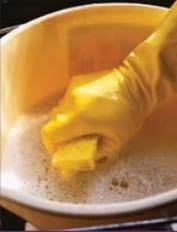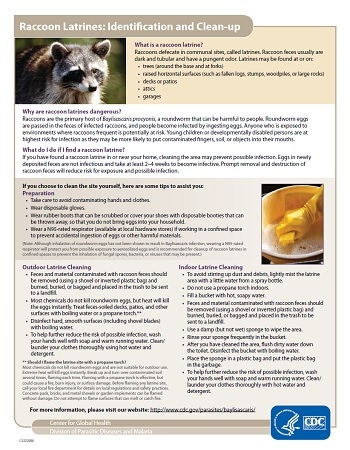Raccoon Latrines: Identification and Clean-up
What is a raccoon latrine?
Raccoons defecate in communal sites, called latrines. Raccoon feces usually are dark and tubular and have a pungent odor. Latrines may be found at or on:
- trees (around the base and at forks)
- raised horizontal surfaces (such as fallen logs, stumps, woodpiles, or large rocks)
- decks or patios
- attics
- garages
Why are raccoon latrines dangerous?
Raccoons are the primary host of Baylisascaris procyonis, a roundworm that can be harmful to people. Roundworm eggs are passed in the feces of infected raccoons, and people become infected by ingesting eggs. Anyone who is exposed to environments where raccoons frequent is potentially at risk. Young children or developmentally disabled persons are at highest risk for infection as they may be more likely to put contaminated fingers, soil, or objects into their mouths.
What do I do if I find a raccoon latrine?
If you have found a raccoon latrine in or near your home, cleaning the area may prevent possible infection. Eggs in newly deposited feces are not infectious and take at least 2–4 weeks to become infective. Prompt removal and destruction of raccoon feces will reduce risk for exposure and possible infection.
If you choose to clean the site yourself, here are some tips to assist you:
Preparation
- Take care to avoid contaminating hands and clothes.
- Wear disposable gloves.
- Wear rubber boots that can be scrubbed or cover your shoes with disposable booties that can be thrown away, so that you do not bring eggs into your household.
- Wear a N95-rated respirator (available at local hardware stores) if working in a confined space to prevent accidental ingestion of eggs or other harmful materials.
(Note: Although inhalation of roundworm eggs has not been shown to result in Baylisascaris infection, wearing a N95-rated
respirator will protect you from possible exposure to aerosolized eggs and is recommended for cleanup of raccoon latrines in
confined spaces to prevent the inhalation of fungal spores, bacteria, or viruses that may be present.)

Outdoor Latrine Cleaning
- Feces and material contaminated with raccoon feces should be removed (using a shovel or inverted plastic bag) and burned, buried, or bagged and placed in the trash to be sent to a landfill.
- Most chemicals do not kill roundworm eggs, but heat will kill the eggs instantly. Treat feces-soiled decks, patios, and other surfaces with boiling water or a propane torch.**
- Disinfect hard, smooth surfaces (including shovel blades) with boiling water.
- To help further reduce the risk of possible infection, wash your hands well with soap and warm running water. Clean/launder your clothes thoroughly using hot water and detergent.
** Should I flame the latrine site with a propane torch?
Most chemicals do not kill roundworm eggs and are not suitable for outdoor use. Extreme heat will kill eggs instantly. Break up and turn over contaminated soil several times, flaming each time. Flaming with a propane torch is effective, but could cause a fire, burn injury, or surface damage. Before flaming any latrine site, call your local fire department for details on local regulations and safety practices. Concrete pads, bricks, and metal shovels or garden implements can be flamed without damage. Do not attempt to flame surfaces that can melt or catch fire.

Indoor Latrine Cleaning
- To avoid stirring up dust and debris, lightly mist the latrine area with a little water from a spray bottle.
- Do not use a propane torch indoors.
- Fill a bucket with hot, soapy water.
- Feces and material contaminated with raccoon feces should be removed (using a shovel or inverted plastic bag) and burned, buried, or bagged and placed in the trash to be sent to a landfill.
- Use a damp (but not wet) sponge to wipe the area.
- Rinse your sponge frequently in the bucket.
- After you have cleaned the area, flush dirty water down the toilet. Disinfect the bucket with boiling water.
- Place the sponge in a plastic bag and put the plastic bag in the garbage.
- To help further reduce the risk of possible infection, wash your hands well with soap and warm running water. Clean/launder your clothes thoroughly with hot water and detergent.
For more information on Baylisascaris and raccoon latrine clean-up, please visit the CDC Baylisascaris website at www.cdc.gov/parasites/baylisascaris or call 1-800-CDC-INFO.
